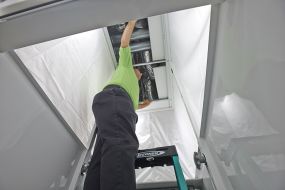What is a Containment Unit and How Does it Work?

Like everything else in the modern world, technology changed the way that we form isolation rooms. This technology is used for protecting patents in hospitals, during renovations and other circumstances when there is a risk of contamination entering the air that we breathe. Limiting contaminants that enter the lungs or respiratory system means breathing fresher air and creating a healthier body, and limits the risk of spreading pollutants and viruses (like COVID-19) around. It was not that long ago that creating a contamination room required a lot of time and materials, and when it was no longer required, time and resources were used to remove the construction. Today there is a better option. The mobile contamination unit is the technology that creates a safe environment quickly.
What is a mobile containment unit?
A mobile containment unit is like an isolation room, but it is portable. This unit can be brought into room to separate it from the building-wide air exchange. The ECU4 is a multi-functional unit, has lightweight flame resistant poly fabric with resin zippers and a double reinforced nylon floor. All four doors have windows. This is useful when working with patients in a healthcare setting. This unit has an external frame that makes it easy to clean and sanitize before, during and after each use.
These containment units are designed to trap and prevent pollutants from leaving the space and traveling throughout the rest of the building. When renovations are being completed workers can stay in the unit and the dust will not travel through the air. In a hospital these units can be used as an isolation room. The unit can be installed as an entrance to the room or two units can be joined together to make a larger room for a patient. The unit will keep airborne pathogens from getting in or out.
Negative air pressure
A mobile containment unit can be attached to an air scrubber. This will create negative air pressure. The air flow is sucked into the room. The air is filtered through a scrubber, then flows back through the room, adding another layer of protection and increasing indoor air quality.
An air scrubber can be attached to the unit to help prevent and control the spread of disease in a health center. Unlike a purifier, which basically just traps particles in a filter, an air scrubber will destroy these particles. They are filtered but then these particles are run through a germicidal UV light wave and a catalytic process is used to destroy the germs. An air scrubber can be used outside of healthcare settings too.
Other reasons why a containment unit would be attached to an air scrubber is to get rid of smells. When rooms have foul smells such as paint, mold or fire/smoke damage, the smells can be contained to a single room while the work is being completed.
Four reasons to use a mobile containment unit in a healthcare center
1) Large renovations. When healthcare centers are completing renovations, it is essential to ensure that particles are not floating through the air where vulnerable people are able to breathe them in.
2) Daily maintenance. Because of the mobility and ease to assemble these units, they do not need to be for just large projects. They can be used nearly anywhere, anytime.
3) Ceiling access. Because there is no outlet for dust and particles in an attic or enclosed ceiling, debris will reduce indoor air quality when work in that area must be performed. A containment unit helps prevent the spread of dust throughout the building when the attic and ceiling are disturbed.
4) Data server rooms. The world depends on technology, including servers for digital information. A containment unit can be set up to protect the servers (which are vulnerable to dust) especially during renovations.
Conclusion
This technology is changing the way that buildings, including healthcare centers, are set up for renovations or used in emergencies such as pandemics. The mobile containment unit is easy to transport and set up and within minutes your room has floor-to-ceiling protection from the spread of dust and other harmful particles.




